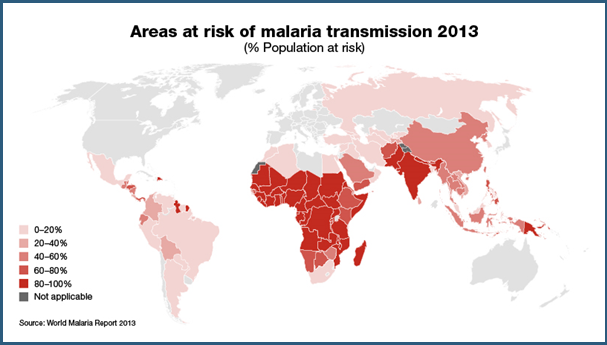Malaria News
An infected mosquito acts as the carrier for the parasite plasmodium, which enters the blood stream of humans when bitten. Humans are susceptible to 4 types of malaria; Plasmodium falciparum, P. vivax, P. ovale, and P. malariae.
The parasite is transported to the liver, where it multiplies and infects red blood cells. This inhibits the body’s ability to properly supply blood to the vital organs. Symptoms first appear after the parasite multiplies to a certain extent, often 10-30 days after being bitten by the carrier mosquito. However, this period varies as some cases have reported symptoms as early as 7 days, or as late as 1 year after exposure. The asymptomatic period is also highly dependent on the type of malaria with which the individual is infected.
According to the World Health Organisation, 2013 alone saw 198 million clinical cases of malaria reported worldwide, with 500,000 resulting deaths. The vast majority of malaria related fatalities were those of African elderly people, children and infants.

What are the symptoms of malaria?
The initial symptoms of malaria include…
Flu-like illness, Fever, Headaches, Chills, Shaking, Fatigue, Muscle pains, Nausea.
The condition of an infected individual rapidly degenerates, leading to disruption of blood supply to vital organs and reduced red blood cell count. Severe symptoms include…
Anaemia, Jaundice (recognisable by yellowing of the eyes and skin), mental confusion, Kidney failure, Seizures, Coma.
If left unchecked, these symptoms end in fatality. Those most at risk include individuals with weaker immune systems, such as infants and children, the elderly, and people affected by HIV.
For most effective treatment, it is vital that the disease is discovered as early as possible after symptoms appear. This is done by clinical blood testing to detect the presence of the parasite under a microscope.
Malaria treatments are usually comprised of artemisinin-based combination therapies, taken orally or intravenously depending on the progression of the disease.
Malaria is transmitted exclusively by the infected female Anopheles mosquito, as only females bite humans for blood. Mosquitoes become infected by having previously fed on the blood of an infected human.
Mosquitoes inject a small amount of saliva into the organism it feeds on, as the saliva contains an agent which locally thins the blood. This makes it easier for the mosquito to extract the blood from the organism. Mosquitoes infected with plasmodium contain the parasite in the saliva, which is transmitted to the human in the process of biting them.
How can we prevent being infected with Malaria?
Contrary to urban myth, there is no way to visually detect whether a mosquito is a carrier of the malaria parasite. In order to combat malaria, Prevention is Key:
Anti-Malarial Drugs
Short term prevention (often utilised by foreign visitors to Africa and Asia) include anti-malarial drugs such as paludrine and chloroquine. These are usually avoided for usage beyond 1 year due to reduced efficacy over time, and negative side-effects including nausea and blurred vision.
Mosquito Nets
The most widely used preventative measure for contracting malaria are mosquito nets, as they prevent all contact with mosquitoes. Mosquito nets can be treated in a way which repels mosquitoes, making them the most effective prevention for malaria.
Avoid getting bitten during the day
Mosquitoes are less active during the day time, however one bite is all it takes for infection. Using insect repellents containing DEET and wearing long sleeved clothing reduces the chances of being bitten.
Efforts to reduce Malaria in Mozambique and the world
Foreign aid organisations such as UNICEF, Save the Children and USAID have worked closely in conjunction with MISAU (Ministerio da Saude de Moçambique) in order to reduce malaria related fatalities and infections in Mozambique. Actions include the mass distribution of circular mosquito nets to impoverished and rural areas, and informing locals to recognise symptoms of malaria. The aim is to encourage locals to be tested as soon as possible and receive treatment to reduce deaths resulting from malarial infection.
The World Health Organisation has taken huge steps in the global fight against malaria in recent months. May 20th 2015 marks the most recent World Health Assembly, wherein a new global strategy has been created to reduce deaths resulting from malaria worldwide. As stated on their website,

“The World Health Assembly has adopted a new global technical strategy for malaria, setting ambitious goals and targets for the next 15 years. Forty-one countries took the floor during the discussion – including Malawi speaking on behalf of the 47 countries of the African Region, and Indonesia speaking on behalf of the 11 countries of the South-East Asia Region. By adopting this strategy, Member States have set the target of reducing global malaria incidence and mortality rates by 90% by 2030.”
